NVIDIA Quadro P620 Compute Related Benchmarks
As we move along with the GPU testing we felt it was time to clean up our database and results in graphs, we have dropped the Silent and OC results for each card and kept the fresh out of box numbers. Doing so made our graphs much easier to read, many users here at STH do not run cards in those configurations or simply cannot do so in Linux based systems so this was warranted. We still have our test numbers and might revisit those settings later on.
Uses cases for the NVIDIA Quadro P620 would not be for high-end graphics, heavy compute tasks or major CAD/Render work, we do not expect to see benchmark results above the bottom of our charts, but none the less, the Quadro P620 handles lighter duty tasks fine. Also, our benchmarks are run on a 4K display which the P620 can handle for general purpose work. Lower screen resolutions might be better for more demanding workloads. Some users report using graphics cards like the P620 for proof of concepts with small data sets before pushing to higher-end costly larger systems to not waste available compute time.
Geekbench 4
Geekbench 4 measures the compute performance of your GPU using image processing to computer vision to number crunching.
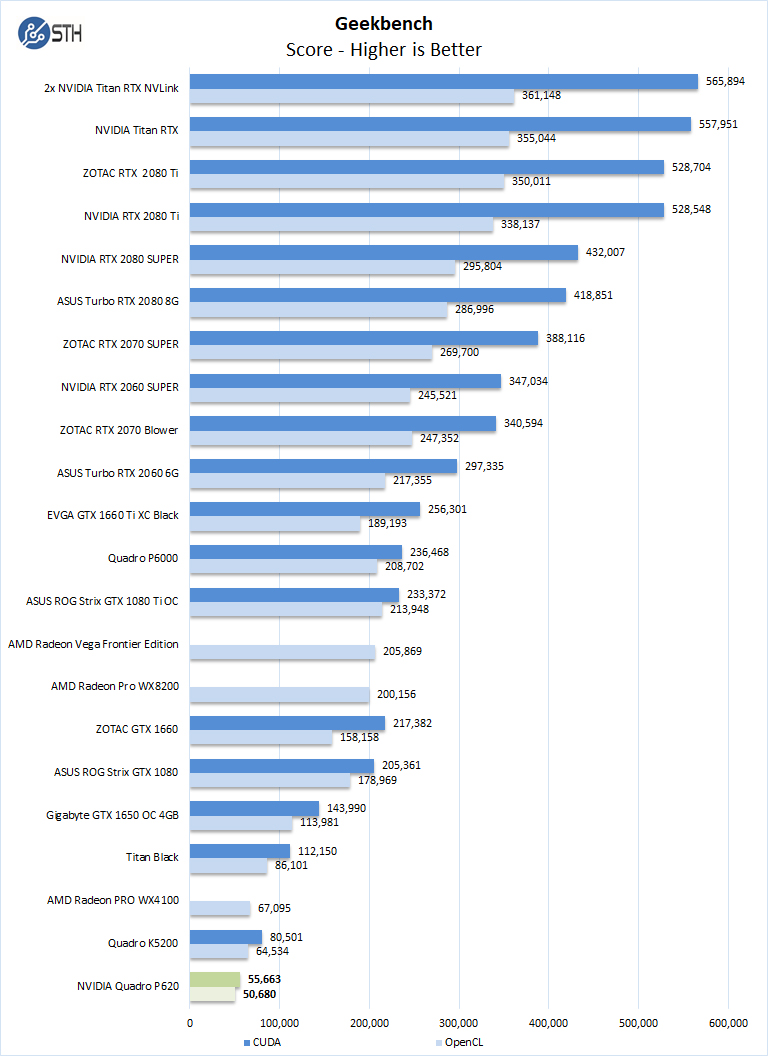
Our first compute benchmark we see the NVIDIA Quadro P620 achieve results near an NVIDIA Quadro K5200 which is a much larger full-size double slot GPU, for OpenCL workloads. We expect to see this trend throughout our benchmarks.
LuxMark
LuxMark is an OpenCL benchmark tool based on LuxRender.
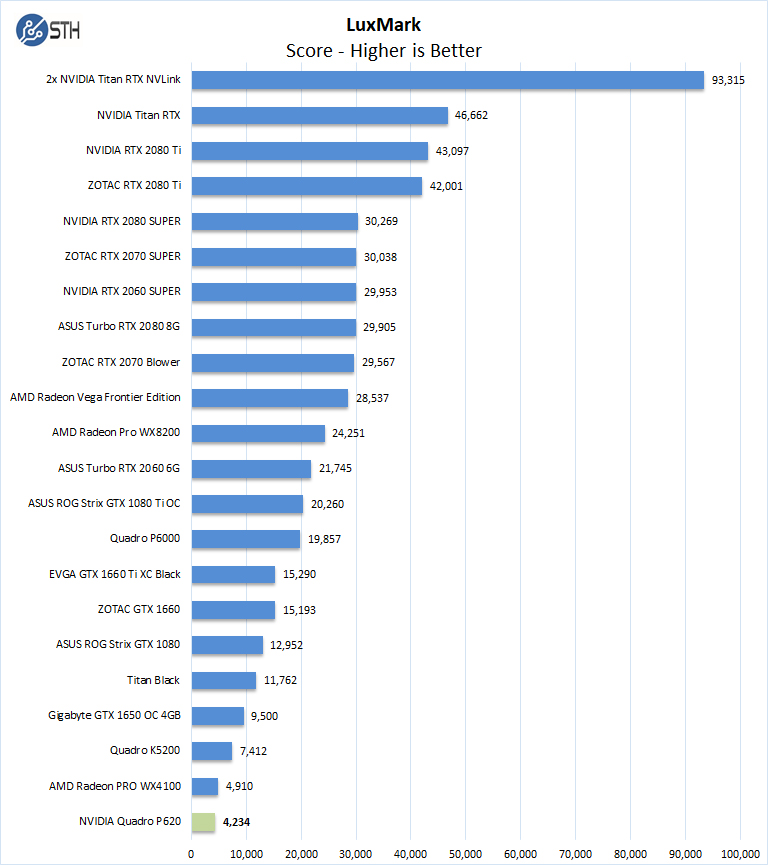
With LuxMark results, we find the Quadro P620, falls to the bottom of the chart, most modern GPU’s are able to achieve these results with ease.
AIDA64 GPGPU
These benchmarks are designed to measure GPGPU computing performance via different OpenCL workloads.
- Single-Precision FLOPS: Measures the classic MAD (Multiply-Addition) performance of the GPU, otherwise known as FLOPS (Floating-Point Operations Per Second), with single-precision (32-bit, “float”) floating-point data.
- Double-Precision FLOPS: Measures the classic MAD (Multiply-Addition) performance of the GPU, otherwise known as FLOPS (Floating-Point Operations Per Second), with double-precision (64-bit, “double”) floating-point data.
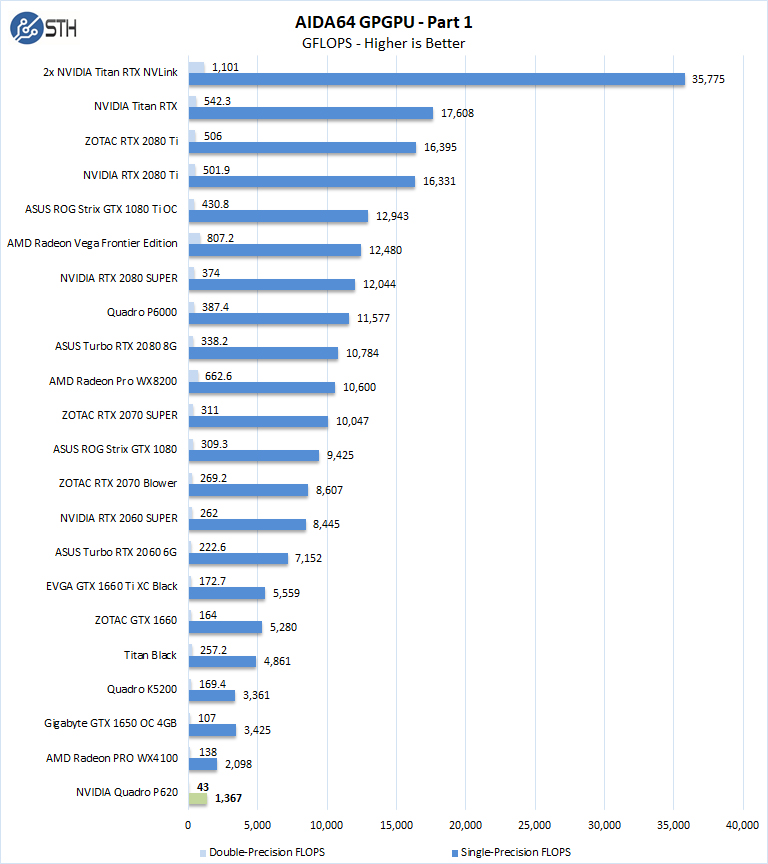
The next set of benchmarks from AIDA64 are:
- 24-bit Integer IOPS: Measures the classic MAD (Multiply-Addition) performance of the GPU, otherwise known as IOPS (Integer Operations Per Second), with 24-bit integer (“int24”) data. This particular data type defined in OpenCL on the basis that many GPUs are capable of executing int24 operations via their floating-point units.
- 32-bit Integer IOPS: Measures the classic MAD (Multiply-Addition) performance of the GPU, otherwise known as IOPS (Integer Operations Per Second), with 32-bit integer (“int”) data.
- 64-bit Integer IOPS: Measures the classic MAD (Multiply-Addition) performance of the GPU, otherwise known as IOPS (Integer Operations Per Second), with 64-bit integer (“long”) data. Most GPUs do not have dedicated execution resources for 64-bit integer operations, so instead, they emulate the 64-bit integer operations via existing 32-bit integer execution units.
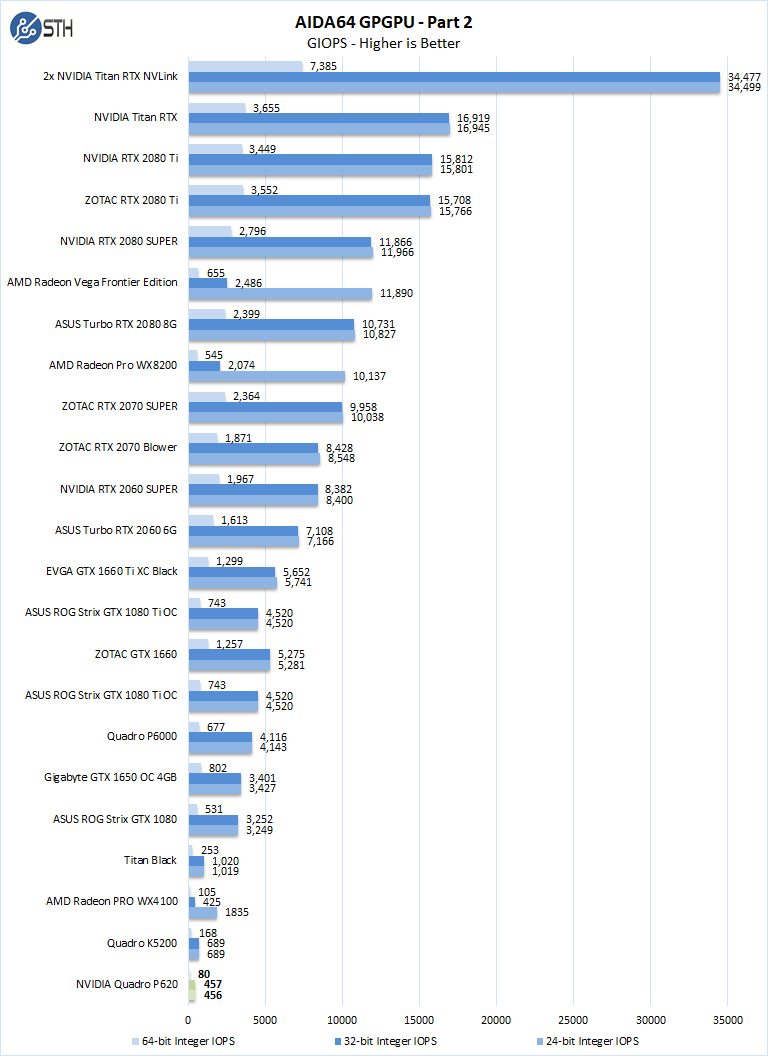
If you think we are going to see a trend we are. These cards are running at about 1/10th the speed of an NVIDIA GeForce GTX 1660.
hashcat64
hashcat64 is a password cracking benchmarks that can run an impressive number of different algorithms. We used the windows version and a simple command of hashcat64 -b. Out of these results we used five results to the graph. Users who are interested in hashcat can find the download here.
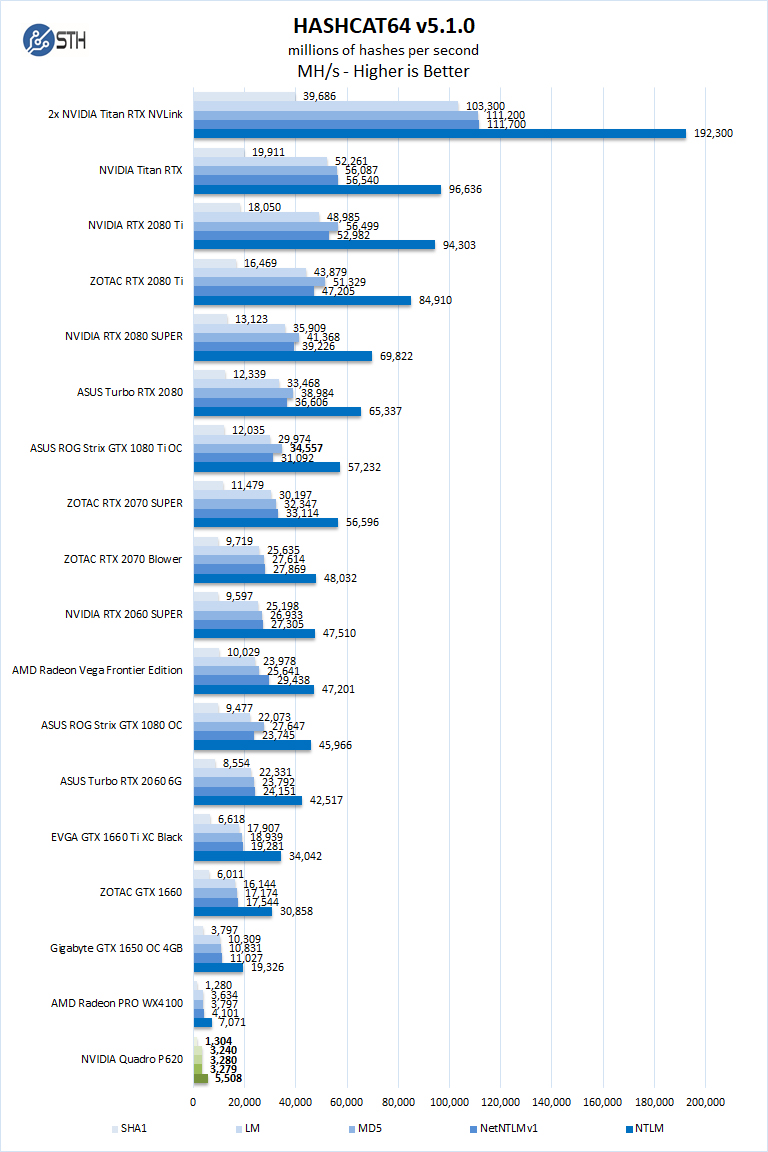
We were a bit surprised in this test that the Quadro P620 was so close to the AMD Radeon PRO WX 4100. Typically this is a workload AMD performs very well in.
SPECviewperf 13
SPECviewperf 13 measures the 3D graphics performance of systems running under the OpenGL and Direct X application programming interfaces.
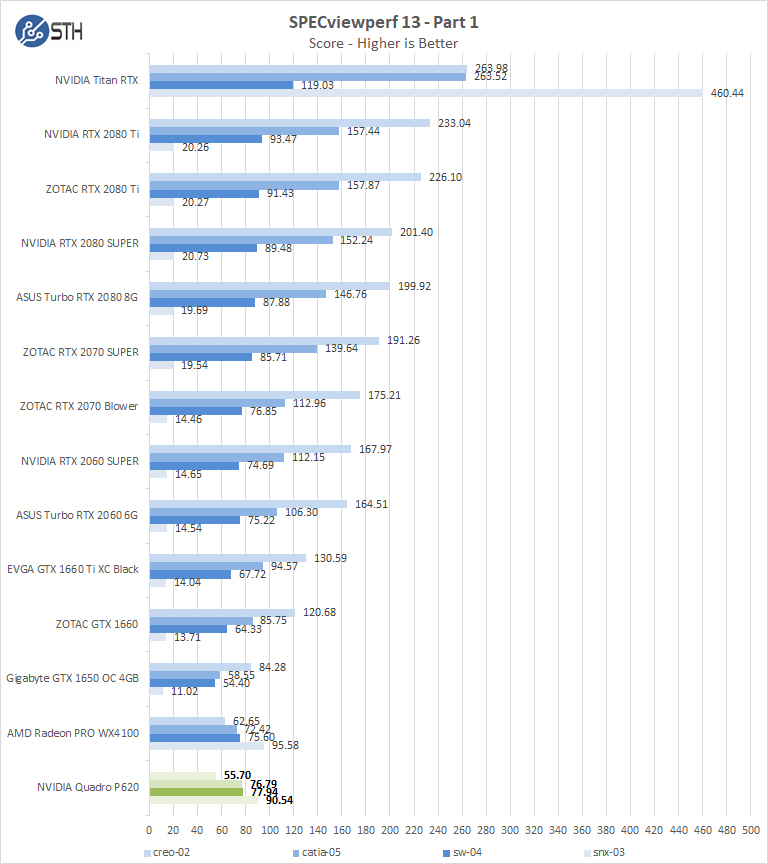
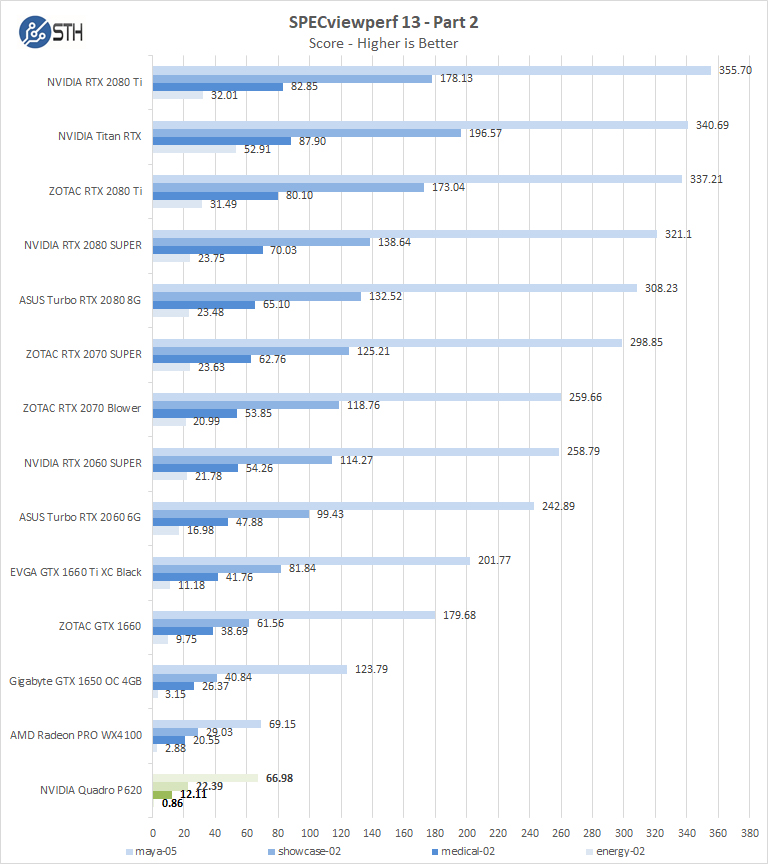
Again we see the Quadro P620 in direct competition with the AMD Radeon PRO WX 4100.
Let us move on and start our new tests with rendering-related benchmarks.




Well, that isn’t very powerful is it. Maybe that’s the point? That 4 miniDP is why we use them in Xeon E-2100 systems to power dashboards. Onboard video sucks because you’ve got different connectors. When you’re powering four displays it’s nice to have one cable.
@brianmc that’s exactly the point, we recently did a build with a pair of p600’s(the immediate predecessor to this card less shaders slightly higher clock) because it needed to power 8 4k displays. Nothing fancy just plating video on it we just needed as small as possible(we used a 2u server case inside a 4u mobile rack with cables and such in the other 2u) and 8 displays. These were chosen over other options(like the 4100) due to our own bias and already having a p600
the p620 can handle 3-4 HD stream for home media server like plex ?
for now the best solution for home is the p2000 but it’s expensive for only homing use
@stefan marton NVENC on the P600(and therefore the P620 presumably)is offcially limited to 2 concurrent sessions as are all gpu’s below the P2000. Unofficall drivers may alter that and you can find details on some of that in the forum however out of the box the chip will stop at 2 streams regardless of how many it can actually handle.
https://forums.servethehome.com/index.php?threads/nvidia-quadro-p2000-new-for-350.25140/#post-233204
@Daniel Smith thanks now i think to buy a p2000 with unraid i dont want to buy a 1050ti or 1060 and the fix stop to work and waste my money because a need 3-4 stream for home server
Despite having the name “Quadro” in it, this card may be too limited featurewise for certain tasks. For instance, the P600 does not support pass through (confirmed by an nvidia employee here: https://devtalk.nvidia.com/default/topic/1025830/miscellaneous/error-code-43-after-install-quadro-p600/ )
I think this is true for the P620 as well. You can get that to work though. For instance, I had to switch to OVMF instead of using SeaBIOS
I too have used this Graphics card for a while and I am perfectly satisfied with the card as it is Low Profile, Low Power Graphics that is perfectly good going for me. If someone is looking for something for a small purpose and I would highly suggest them.
Using this card for video decoding of multiple streams to offload the cpu in a SFF pc. Old i7 intel went from 100% consumption to 30% and the p620 runs around 50% on decode consumption.
p600 supports pci passthrough with no issues on vsphere 6.7u3 to windows and ubuntu by editing the passthru.map with d3d0 https://www.reddit.com/r/Amd/comments/72ula0/tr1950x_gtx_1060_passthrough_with_esxi/
To unlock multiple streams just patch it. https://github.com/keylase/nvidia-patch
I use Quadro P620 on my SFF case and quite often I do 4K video encoding which pushes the temperature somewhere between 65-70 degree celsius and it gets little toasty. The ideal use case for these cards are mostly for multi display support unless you have a very good case with good cooling system. It’s a great card for any non-gaming machine.
p620 same price as wx4100, which one should i chose?
i using autocad and intericad – 2d and 3d rendering.
Dont know why but my p620 on idle is using 17w ???
and is a bit loud in idle fan is on 34%
my p620 also idles at 17watts, and 39°c with 30% fan speed. Power optimized doesn’t help at all in Nvidia control panel and power management. Do they use a different driver? Or it’s just because it’s always like that?
It’s says the power consumption of the whole graphics card so that includes the VRM and VRAM(GDDR5) running together. I still don’t understand though. I want the watts and temps of this review :<